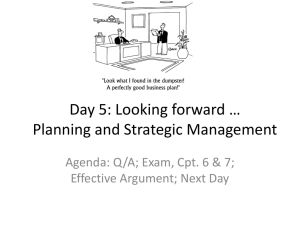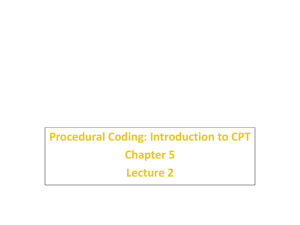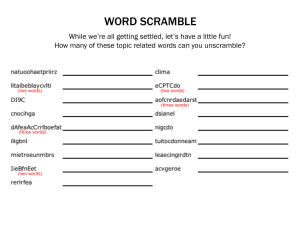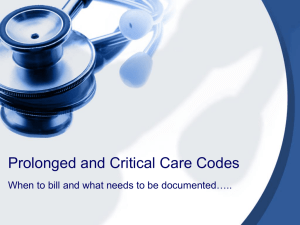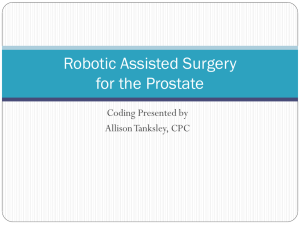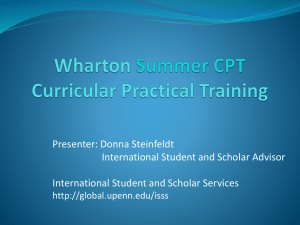Chapter 15
advertisement
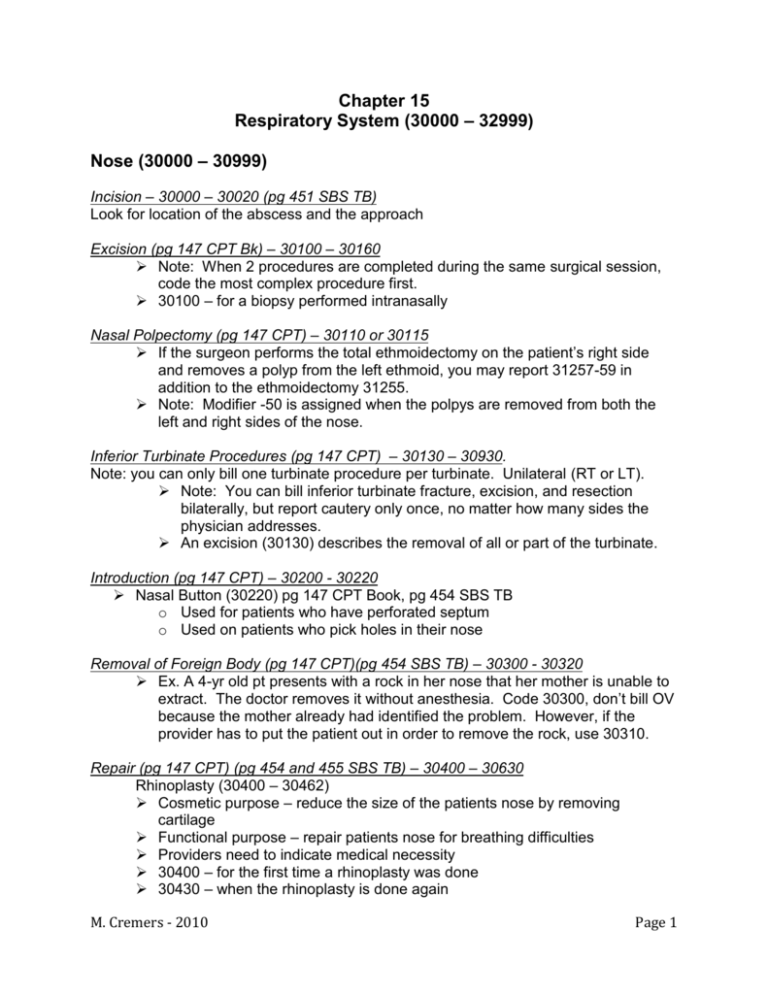
Chapter 15 Respiratory System (30000 – 32999) Nose (30000 – 30999) Incision – 30000 – 30020 (pg 451 SBS TB) Look for location of the abscess and the approach Excision (pg 147 CPT Bk) – 30100 – 30160 Note: When 2 procedures are completed during the same surgical session, code the most complex procedure first. 30100 – for a biopsy performed intranasally Nasal Polpectomy (pg 147 CPT) – 30110 or 30115 If the surgeon performs the total ethmoidectomy on the patient’s right side and removes a polyp from the left ethmoid, you may report 31257-59 in addition to the ethmoidectomy 31255. Note: Modifier -50 is assigned when the polpys are removed from both the left and right sides of the nose. Inferior Turbinate Procedures (pg 147 CPT) – 30130 – 30930. Note: you can only bill one turbinate procedure per turbinate. Unilateral (RT or LT). Note: You can bill inferior turbinate fracture, excision, and resection bilaterally, but report cautery only once, no matter how many sides the physician addresses. An excision (30130) describes the removal of all or part of the turbinate. Introduction (pg 147 CPT) – 30200 - 30220 Nasal Button (30220) pg 147 CPT Book, pg 454 SBS TB o Used for patients who have perforated septum o Used on patients who pick holes in their nose Removal of Foreign Body (pg 147 CPT)(pg 454 SBS TB) – 30300 - 30320 Ex. A 4-yr old pt presents with a rock in her nose that her mother is unable to extract. The doctor removes it without anesthesia. Code 30300, don’t bill OV because the mother already had identified the problem. However, if the provider has to put the patient out in order to remove the rock, use 30310. Repair (pg 147 CPT) (pg 454 and 455 SBS TB) – 30400 – 30630 Rhinoplasty (30400 – 30462) Cosmetic purpose – reduce the size of the patients nose by removing cartilage Functional purpose – repair patients nose for breathing difficulties Providers need to indicate medical necessity 30400 – for the first time a rhinoplasty was done 30430 – when the rhinoplasty is done again M. Cremers - 2010 Page 1 Chapter 15 Respiratory System (30000 – 32999) Septoplasy (30520) pg 148 CPT, pg 455 SBS TB provider is usually repairing a deviated septum. Watch notes under CPT code Destruction – 30801 – 30999pg 148 CPT, pg 455 SBS TB Abalation – removal by cutting Intramural – abalation of the deeper mucosa Superficial – abalation which involves the outer layer of mucosa Other procedures (30901 – 30999) pg 148 CPT, pg 455 SBS TB) Used for the control of nasal hemorrhage o Look for the type of control and the level of complexity Accessory Sinuses (31000 – 31299) pg 188 CPT, pg 457& 458 SBS TB 31000 - Lavage – sinuses are washed with saline which is put in a canula to remove infection, use modifier -50 if done on both sides Sinusotomy – procedure in which the physician enlarges the passage or creates a new passage from the nasal cavity into the sinus. Normally done due to chronic sinus infections. Caldwell-Luc Procedure (31030 – 31031) – pg 148 CPT - provider has to gain access to and enter the maxillary sinuses through the gum for removal of polyp. Sinus Endoscopies 31231 – 31294 – unilateral (pgs 449, 450 SBS TB), pg 149-150 CPT Note: if sinus endoscopy is diagnostic, code states unilateral or bilateral Code to the full extent of the procedure Code the correct approach to the procedure If multiple endoscopies performed, use modifier -51 Diagnostic sinus endoscopies are bundled into a surgical endoscopy, code the surgical endoscopy as it has a higher value. However if diagnostic endoscopy performed on one side and a surgical endoscopy on the left side, use RT/LT modifiers Nasal endoscopic procedures are different from intranasal procedures Ethmoidectomy (31200 – 31255) pgs 149 – 150 CPT removal of diseased tissue from the ethmoid sinuses to treat infection and remove obstructions o You can separately report a middle turbinectomy if the ENT performs it on the opposite side of the nose from the ethmoidectomy. M. Cremers - 2010 Page 2 Chapter 15 Respiratory System (30000 – 32999) CSF Leak Repair (cerebrospinal fluid leak) (31290 – 31291),pg 150-151 CPT Orbital Wall decompression (31292 – 31294) pg 151 CPT Book the bone surrounding the eye to treat conditions such as Grave’s disease Can use -50 or RT/LT Postseptoplasty Debridement (31237) pg 150 CPT – use modifiers 79 or 58 on debridement code if done during the post op period of the Septoplasty. Larynx (31300 – 31599) pg 151 CPT, pg 458-459 SBS TB Note: The codes in the Laryngotomy category codes describe procedures in which the surgeon performs a thyrotomy for the purpose of exposing the larynx The codes in the Trachea and Bronchi subheading, incision category describe a procedure in which the surgeon performs only the tracheostomy and the larynx is not exposed. Laryngectomy (31360 – 31382) (pg 151 CP) – Most often performed to treat patients for cancer. 31360 – Laryngectomy for one side and 38724-59 for bilateral modified radical neck dissection 31365 – This code only covers a unilateral radical neck resection. If performed on both side – use 31365 for first side and 38720-59 for second side. Keep in Mind: Laryngectomies always include permanent tracheostomies. Do not report 31600. Also includes thyroidectomy. Laryngoscopy (pg 152 CPT) - (31505 – 31579). 29 procedures divided into the following 3 groups (indirect, direct, flexible) the groups are further broken down by function including but not limited to (diagnostic, with biopsy, with removal of foreign body) (with removal of lesion) 31520 – use when the ENT changes a tracheostomy tube before the fistula track has become established. Confer with provider to find out when the fistula tract becomes established. o Note: For trach tube changes in the office, nursing home or bedside after the fistula track has healed, you should consider the trach change as a factor when deciding on a level of E/M. Keep in Mind: If a procedure that began as an indirect or flexible laryngoscopy had to be converted to a direct scope, you can only bill the direct scope. M. Cremers - 2010 Page 3 Chapter 15 Respiratory System (30000 – 32999) Note: Nasopharyngoscopy - pg 152 CPT 92511 – examines the nasopharynx and the edge of the soft palate. 31575 – examines the larynx o If the clinician does not perform recording, report 92700. The swallowing eval codes all include the flexible laryngoscopy and 31575 is NOT separately billable. Laryngeal Web – 31580 (pg 152 CPT, pg 459 SBS TB) Performed in 2 stages Trachea and Bronchi – 31600 – 31899 (pg 152 – 154 CPT), pg 460-461 SBS TB Tracheostomy (31600 – 31601) o Note: Trach tube change – the tube change is usually considered part of the E/M services. May be able to bill the supply (check local policies) Watch the approaches Introduction (31715-31730) pg 154 CPT Book, pg 462 SBS TB Report catheritization, instillation, injection and aspiration of the trachea and the placement of tubes into the trachea Excision and Repair (31715-31830) pg 154 CPT Book, pg 462 SBS TB) Include plastic repairs, such as tracheoplasty and bronchoplasty in addition to the excision of stenosis of or tumors, the suturing of tracheal wounds, and scar revision Lungs and Pleura – 32035 – 32999 Incision (32035-32225) pg 154 CPT pg 463 SBS TB Thoracotomy – making a surgical incision into the chest wall and opening the area to the view of the surgeon. The codes are divided according to the reason for the procedure Chest tubes are bundled into the procedures Excision (32310-32405 pg 154 CPT, pg 463 SBS TB Contains codes for pleurectomy, biopsy, pneumonocentesis, removal, and reconstructive lung procedures Note: Percutaneous needle lung or mediastinum biopsies are often performed under radiologic guidance to the correct placement of the needle can be ensured. M. Cremers - 2010 Page 4 Chapter 15 Respiratory System (30000 – 32999) Removal (32420-32540) pg155 CPT, pg 463 and 464 SBS TB Pneumonocentesis (32420) – withdrawal of fluid from the long by means of an aspirating needle. Codes for the removal of the lung are based on how much of the lung is removed (32440-32540) Thoracentesis (32421-32422) o Chest tube can be inserted to drain accumulating fluid (32551) pg 156 CPT Introduction (32550-32553) pg 156 CPT Destruction (32560-32562) pg 157 CPT Instillation of a fibrinolytic agent to break up the fluid Endoscopy (32601-32856) pg 157 CPT, pg Thoracoscopy – inside of the chest cavity is examined through a fiberoptic endoscope Repair (32800-32856) pgpg 158 CPT Lung Transplantation (32850-32856) pg 158 CPT 3 components of physician work o Cadaver donor pneumonectomy – harvest lung o Backbench work – prep the cadaver donor single or double lung o Recipient lung allotransplantation Surgical Collapse Therapy; Thoracoplasty (32900-32960) pg 158 CPT, pg 465 SBS TB Thoracoplasty (32905-32906) – a portion of the internal skeletal support is removed to treat a condition in which pus chronically collects in the chest cavity. Code includes all stages Pneumonolysis (32940) – performed to separate the inside of the chest cavity from the lung to permit the lung to collapse. Pneumothorax Injection – therapeutic procedure in which the surgeon inserts a needle into the pleural cavity and injects air into the pleural cavity. Other Procedures (32997-32999) (pg 158 CPT) Lung lavage (unilateral) Abalation therapy M. Cremers - 2010 Page 5 Operative Report Indications for Procedure: Pt is a 40-year old male who was involved in an MVA. He is having some pulmonary insufficiency. Procedure: Bronchoscope was inserted through the accessory point on the end of the ET tube and was then advanced thru the ET tube. The ET tube came pretty close down to the carina. We selectively intubated the RT main stem bronchus w/ the bronchoscope. There were some secretions here, and these were aspirated. We then advanced this selectively into first the lower and then the middle and upper lobes. Secretions were present, more so in the middle and lower lobes. No mucous plug was identified. We then went into the left main stem and looked at the upper and lower lobes. There was really not much in the way of secretions present. We did inject some saline and aspirated this out. We then removed the bronchoscope and put the patient back on the supplemental O2. We waited a few minutes. The oxygen level actually stayed pretty good during this time. We then reinserted the bronchoscope and went down to the right side again. We aspirated out all secretions and made sure everything was clear. We then removed the bronchoscope and pulled back on the ET tube about 1.5 cm. We then again placed the patient on supplemental oxygenation. Findings: No mucous plug was identified. Secretions were found mainly in the right lung and were aspirated. The left side looked pretty clear. A. 31646 (Bronchoscopy, rigid or flexible, including fluoroscopic guidance, when performed diagnostic, with cell washing, when performed (separate procedure) with therapeutic aspiration of tracheobroncial tree, subsequent) (518.5 (Pulmonary insufficiency following trauma and surgery), E819.9 (MVA unspecified nature, other specified person – pg 719) wasn’t a subsequent procedure, but a primary procedure – eliminate) B. 32654 , 518.82 (Other pulmonary insufficiency NEC), E812 (Other MVA involving collision w/ motor vehicle – pg 716) (36254 does not exist - eliminate) C. 31645-50 (Bronchoscopy, rigid or flexible, including fluoroscopic guidance, when performed diagnostic, with cell washing, when performed (separate procedure), with therapeutic aspiration of tracheobronchial tree, initial (eg. Drainage of lung abscess) 518.5 (Pulmonary insufficiency following trauma and surgery), E819.9 (MVA unspecified nature, other specified person – pg 719) (indicates same procedure done on both sides and it wasn’t – eliminate) D. 31645-RT (Bronchoscopy, rigid or flexible, including fluoroscopic guidance, when performed diagnostic, with cell washing, when performed (separate procedure), with therapeutic aspiration of tracheobronchial tree, initial (eg. Drainage of lung abscess) 31622-51LT (Bronchoscopy, rigid or flexible, including fluoroscopic guidance, when performed diagnostic, with cell washing, when performed (separate procedure), 518.5 (Pulmonary insufficiency following trauma and surgery), E988.5 (Injury by crashing vehicle, NOS) M. Cremers - 2010 Page 6 This 52-year old has undergone several attempts at extubation, all of which failed. He also has morbid obesity and significant subcutaneous fat in his neck. The patient is now in for a flap tracheostomy and cervical (around your neck area) lipectomy. The cervical lipectomy is necessary for adequate exposure and access to the trachea and also to secure tracheotomy tube placement. Assign code(s) for the physician service only. A. 31610, 15839-51 (Excision, excessive skin and subcutaneous tissue (includes lipectomy; other area – op report indicates surgical area - eliminate) B. 31610 (only indicates the flap tracheostomy – eliminate) C. 31610, 15838 (..submental fat pad - Submental Lipoplasty Double chin surgery) D. 31630 (…with tracheal/bronchial dilation or closed reduction of fracture – eliminate – no fracture mentioned), 15839-51 Operative Report: The patient is in for a bone marrow biopsy. The pt was sterilized by standard procedure. Bone marrow core biopsies were obtained from the left posterior iliac crest with minimal discomfort. At the end of the procedure, the pt denied discomfort, without evidence of complications. The pt has diffuse (to break up and distribute or not concentrated or localized), malignant lymphoma. Assign codes for the physician service only. A. 20225, 229.0 (Benign neoplasm of lymph nodes – eliminate, not malignant) B. 38221 (bone marrow biopsy), 202.80 (Other malignant lymphoma – lymph nodes of multiple sites) – pg 230 C. 38230, 200.10 (Lymphosarcoma, unspecified site – eliminate, site specified) D. 38220 (aspiration – bundled into bone marrow biopsy – eliminate), 202.80 M. Cremers - 2010 Page 7 Operative Report Preoperative Diagnosis: Atelectasis of the left lower lobe Procedure Performed: Fiberoptic bronchoscopy with brushings and cell washings Procedure: The patient was already sedated, on a ventilator and intubated; so his bronchoscopy was done through the ET tube. It was passed easily down to the carina (know this word) about 2 to 2.5cm above the carina, we could see the trachea, which appeared good, as was the carina. In the right lung, all segments were patent and entered, and no masses were seen. The left lung, however, had petechial ecchymotic areas scattered throughout the airways. The tissue was friable and swollen, but no mucous plugs were noted, and all airways were open, just somewhat swollen. No abnormal secretions were noted at all. Brushings were taken as well as washings, mucous plug, but nothing really significant was returned. The specimens were sent to appropriate cytological and bacteriological studies. The pt tolerated the procedure fairly well. A. 31622, 31623-51, 518.0 (Atelectasis) – eliminate – separate procedure (RT,LT, lobes can be distinguished as the right and left side, versus being bilateral) B. 31623, 770.4 (Primary atelectasis – eliminate, incorrect dx) C. 31622-RT ((Bronchoscopy, rigid or flexible, including fluoroscopic guidance, when performed diagnostic, with cell washing, when performed (separate procedure), 31623-51LT, 518.0 D. 31624 (…with bronchial alveolar lavage – pg 153), 770.4 (eliminate – incorrect dx) Note: In anatomy, the carina is a cartilaginous ridge within the trachea that runs anteroposteriorly between the two primary bronchi at the site of the tracheal bifurcation at the lower end of the trachea. Tracheobronchial injury, an injury to the airways, occurs within 2.5 cm of the carina 40–80% of the time. The ridge separating the openings of the right and left main bronchi at their junction with the trachea. Synonym(s): carina tracheae TA, tracheal carina M. Cremers - 2010 Page 8 M. Cremers - 2010 Page 9

